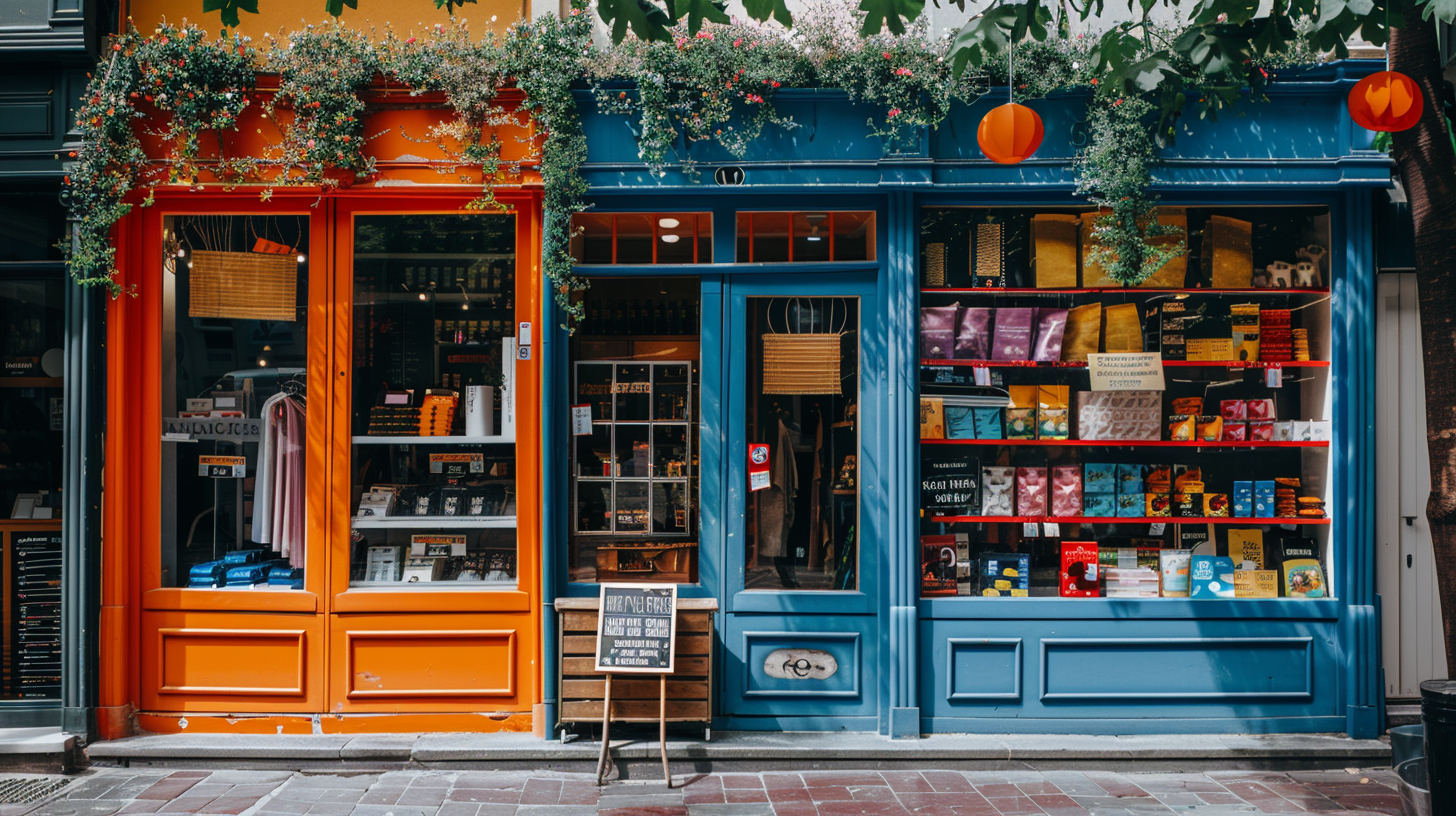Table of Contents Show
As the digital wave crashes over the world of retail, we’re witnessing an unprecedented surge in e-commerce that’s reshaping the landscape beneath our feet. We’ve seen how online shopping platforms flourish while traditional brick-and-mortar stores scramble to keep their doors open. This shift not only alters how we shop but also how retailers strategize to engage with us. As we peel back the layers of this transformation, questions about sustainability, ethical shopping, and the future of physical retail spaces come to the forefront. Let’s explore together what this means for the industry and for us as consumers, understanding the balance between convenience and community.
Key Takeaways
- E-commerce growth leads to fewer store visits, challenging brick-and-mortar retail survival.
- Digital innovations like AR and AI personalize online shopping, setting new consumer expectations.
- Brick-and-mortar stores are adapting through digital transformations and experiential offerings.
- Omnichannel strategies are vital for retail to offer seamless experiences across online and in-store platforms.
The E-Commerce Explosion
In recent years, we’ve witnessed an unprecedented explosion in e-commerce, fundamentally reshaping the retail landscape. It’s as if overnight, the digital marketplace became the go-to destination for our shopping needs, offering a level of convenience traditional stores could hardly match. We’re no longer bound by store hours or geographic limitations; the world’s marketplace is at our fingertips, anytime, anywhere.
This surge in online shopping hasn’t just changed where we buy; it’s redefined how retailers operate. Brick-and-mortar stores that once thrived on foot traffic are now pivoting to establish a robust online presence. We’re seeing a blend of the physical and digital worlds, where the convenience of online shopping meets the tactile experience of in-store browsing. Retailers are adopting innovative technologies, from virtual fitting rooms to AI-driven personal shopping assistants, to bridge this gap.
Additionally, the rise of e-commerce has democratized the retail playing field. Small businesses and artisans now have the opportunity to reach a global audience, something that was nearly impossible in the pre-digital era. This shift has ignited a sense of freedom among entrepreneurs and consumers alike. We’re no longer limited to what’s available locally; we can support businesses from around the globe, all from the comfort of our homes.
The e-commerce explosion has indeed marked a new era in retail, offering unprecedented freedom and flexibility. As we continue to navigate this digital marketplace, it’s clear that the future of retail is not just online but everywhere – adapting and evolving with us, wherever we go.
Changing Consumer Behaviors
As we explore the evolution of retail further, it’s clear that e-commerce has greatly altered consumer behaviors. The convenience of shopping from anywhere at any time has not just been a shift; it’s transformed how we think about purchasing. We’re no longer bound by store hours or locations, giving us the freedom to shop in a way that fits our lives, not the other way around.
This newfound liberty has led us to expect more – more options, faster shipping, and personalized experiences. We’re used to having the world at our fingertips, and our patience for anything less has dramatically decreased. The ability to compare prices, read reviews, and make informed decisions without leaving our homes has put us in control. We’re smarter shoppers now, savvy and discerning, always seeking the best deal or the most unique item.
Additionally, the rise of social media and influencer culture has heavily influenced our purchasing decisions. We’re not just buying products; we’re buying into lifestyles and ideals presented to us in curated feeds. This has made us value authenticity and transparency more than ever. We want to know where our products come from, who makes them, and the story behind them. It’s not just about the transaction; it’s about the connection.
E-commerce hasn’t just changed shopping; it’s revolutionized it. We’ve embraced these changes, enjoying the freedom and control we now have over our consumer experiences. As we continue to evolve with the digital age, it’s exciting to think about what new freedoms and innovations lie ahead.
Impact on Foot Traffic
We’ve observed a significant decline in store visits as consumers increasingly turn to online shopping. This shift has also led to a surge in digital window shopping, where browsing online stores has become the norm. Let’s explore how these trends are reshaping foot traffic in retail spaces.
Declining Store Visits
E-commerce’s rise has led to a notable decrease in store visits, considerably impacting foot traffic in retail spaces. We’re witnessing a shift where convenience trumps tradition, pushing us to rethink our shopping habits. This decline isn’t just about fewer people milling around in malls; it’s a signal of changing consumer preferences. We’ve embraced the freedom to shop from anywhere, anytime, leaving physical stores to adapt or face dwindling visitor numbers.
Retailers are now in a race to offer experiences that can’t be replicated online, aiming to draw us back in. Yet, the question remains: can these efforts match the allure of shopping with a click? As we continue to value our freedom and convenience, only time will tell how brick-and-mortar stores will evolve to keep pace.
Digital Window Shopping Surge
The surge in digital window shopping has greatly reduced foot traffic in retail stores, presenting a new challenge for physical retailers. We’re seeing a significant shift as shoppers opt for the convenience of browsing online over the traditional in-store experience. This trend isn’t just changing how we shop; it’s reshaping the retail landscape.
| Aspect | Physical Retail Impact | Online Advantage |
|---|---|---|
| Shopping Experience | Less personalized | More convenient |
| Product Discovery | Slower | Instant |
| Deals & Promotions | Less dynamic | More frequent & tailored |
We’ve got to address this shift head-on. By integrating online elements into physical stores, such as virtual try-ons or online-exclusive deals redeemable in-store, we can recapture the freedom of choice and convenience that today’s shoppers desire, blending the best of both worlds.
The Struggle for Survival
Traditional retail stores are facing an uphill battle to remain relevant in the face of growing online shopping trends. We’re in a world where convenience often trumps experience, and we can’t ignore this shift. It’s not just about survival; it’s about asserting our place in a rapidly changing market. We’ve got to struggle for our right to stay in the game, to prove that there’s still something irreplaceable about the physical shopping experience.
We’re seeing a landscape where foot traffic in malls and high streets isn’t what it used to be. It’s a wake-up call, urging us to innovate beyond the conventional. We’re not just selling products; we’re selling an experience, a feeling that can’t be replicated with a click. This is our battleground, and we’re armed with the uniqueness of our in-store experiences, the personal touch, and the community feel that online giants can’t replicate.
But let’s not sugarcoat it; the challenge is immense. Costs are rising, from rent to wages, and the competition isn’t just the shop next door but the entire internet. We’re struggling through a storm, finding ways to draw people in, to give them a reason to choose us over the convenience of online shopping. It’s a struggle, but it’s one we’re not backing down from. We’re exploring every avenue to connect, to engage, and to remind our customers of the joy of shopping in person. We’re fighting for our survival, but more importantly, we’re fighting for our freedom to thrive in an evolving retail world.
Digital Adaptations
Facing the digital tide head-on, we’re pivoting to embrace new technologies and online strategies to enhance our retail experience. The shift isn’t just about survival; it’s about thriving in a world where freedom and choice are paramount. We’re tearing down the walls of traditional retail, offering our customers a seamless bridge between the physical and digital domains. Here’s how we’re doing it:
-
Personalization at Scale: We’re leveraging data to offer personalized shopping experiences, making every customer feel unique and valued. Imagine walking into a store where everything is curated just for you. That’s the freedom we’re bringing to the digital domain.
-
Augmented Reality (AR) Shopping: Trying before buying isn’t just for the physical world anymore. With AR, you can see how that sofa looks in your living room or how those sunglasses fit your face, all from the comfort of your home.
-
24/7 Shopping Assistance****: We’ve introduced AI-driven chatbots and virtual shopping assistants that are available any time of the day or night. No more waiting for store hours to get the help you need.
-
Flexible Fulfillment Options: Freedom means shopping on your terms. That’s why we offer a variety of delivery and pickup options. Whether it’s same-day delivery or curbside pickup, we’re making shopping as convenient as possible.
We’re committed to not just following the digital trend but leading it. It’s about giving you the freedom to shop how, when, and where you want, blending the best of both worlds to create a shopping experience that’s truly liberating.
Innovations in Physical Retail
While we’ve embraced digital innovations to enhance our online presence, we’re also revolutionizing our in-store experiences with cutting-edge physical retail advancements. It’s about creating a space where freedom and choice lead the way, inviting our customers into an environment that’s as dynamic and interactive as the digital world.
We’re integrating smart technologies like augmented reality (AR) to let customers experience before they purchase in a whole new way. Imagine seeing how a piece of furniture fits in your space or how a dress looks on you without the hassle of traditional shopping. It’s freedom at your fingertips.
Interactive displays have transformed the way we think about product exploration. Now, with a simple touch, customers can access a wealth of information, from sourcing to usage tips, making informed choices easier than ever. It’s about giving the power back to the consumer, allowing for a shopping experience that’s tailored, efficient, and engaging.
Personalization is at the heart of our in-store innovations. We’re using data analytics to offer personalized recommendations the moment you walk through our doors. It’s about creating a connection, ensuring every visit is unique and every selection feels handpicked just for you.
This isn’t just about keeping up with e-commerce; it’s about setting a new standard for physical retail. We’re committed to not only meeting our customers where they are but providing an experience that exceeds expectations. The future of retail is here, and it’s more interactive, personalized, and freeing than ever before.
The Role of Omnichannel Strategies
We’re leveraging omnichannel strategies to seamlessly integrate our customers’ online and in-store experiences, ensuring they receive a cohesive and personalized journey regardless of how they choose to shop. This approach isn’t just about survival in a digital age; it’s about thriving by giving our customers the freedom to interact with our brand on their terms. It’s a bold move toward a future where the retail experience is not confined by physical or digital boundaries.
Here’s how we’re making it happen:
- Unified Inventory Management: We’re breaking down the silos between online and in-store inventory, so customers can find what they need, when they need it, without restrictions.
- Flexible Fulfillment Options: Whether it’s same-day delivery or in-store pickup, we’re offering options that fit into our customers’ busy lifestyles, giving them the freedom to choose.
- Consistent Brand Experience: Across all channels, we’re ensuring that our brand’s voice and values are clear, making every interaction feel familiar and trusted.
- Real-time Communication: We’re keeping our customers informed every step of the way, from order confirmation to delivery updates, because we believe in transparency and the freedom it brings.
Personalization and Experience
Building on the foundation of omnichannel strategies, we’re now focusing on elevating the shopping experience through personalization. We acknowledge that today’s shoppers crave freedom and choice more than anything else. They want to feel understood and valued, not just another face in the crowd. That’s where personalization steps in, transforming the shopping journey into something uniquely tailored to each individual.
We’re harnessing data and analytics to provide recommendations that resonate with each customer’s preferences and previous purchases. This isn’t just about suggesting products; it’s about creating a seamless and customized shopping experience that feels effortlessly personal.
We’re reinventing in-store experiences to engage customers more deeply. Imagine walking into a store where the sales staff knows your preferences, or interactive displays provide personalized suggestions. It’s about creating a sense of belonging and connection, making each visit more meaningful than the last.
Personalization goes beyond mere convenience; it’s about freedom. The freedom for customers to shape their shopping experiences, to see reflections of themselves in the products and services they encounter. In this digitally driven era, we’re committed to making shopping not just a transaction, but a personalized journey that resonates on a deeper level.
As we move forward, personalization and experience will continue to be at the heart of our strategies. We’re not just selling products; we’re crafting experiences that speak directly to the individual, offering them the freedom to choose, explore, and connect in ways that matter most to them.
The Future of Malls and Department Stores
As we explore the future of malls and department stores, it’s clear that digital transformation is key to their survival. We’ll examine how malls are adapting to the digital age and what survival strategies department stores are implementing. This discussion will shed light on how these traditional retail spaces are maneuvering the challenges posed by e-commerce.
Malls’ Digital Transformation
In the wake of e-commerce’s rise, malls and department stores are undergoing a digital transformation to remain competitive and relevant in today’s market. We’re embracing technology to create experiences that can’t be replicated online, offering our customers the freedom to choose how they shop, engage, and connect within our spaces.
- Interactive Storefronts – Imagine windows that entertain and invite you in, making every visit unique.
- Personalized Shopping Experiences – Apps that know your style, offering freedom from endless searching.
- Virtual Reality Zones – Spaces where you can escape the ordinary, experiencing products in extraordinary ways.
- Seamless Online-to-Offline Integration – The flexibility to buy online and pick up in-store, or browse in-store and have your choices shipped home.
We’re not just adapting; we’re redefining the shopping experience, ensuring malls and department stores remain cherished destinations.
Department Stores’ Survival Strategies
Beyond adapting through technology, we’re also crafting innovative survival strategies to secure the future of malls and department stores. We’re embracing change, reimagining spaces, and connecting with our communities in new ways to make sure we remain relevant and vibrant. Our approach is centered around freedom – the freedom to explore, to express, and to experience shopping in a way that’s engaging and exciting.
| Strategy | Description |
|---|---|
| Experiential Retail | Transforming spaces into experience hubs. |
| Local Partnerships | Collaborating with local businesses and artists. |
| Digital Integration | Seamlessly blending online and offline shopping. |
| Sustainability Initiatives | Emphasizing eco-friendly practices and products. |
| Community Events | Hosting events to engage and entertain. |
We’re not just surviving; we’re thriving by providing freedom and flexibility to our customers.
Sustainability and Ethical Shopping
We’re delving into how e-commerce is reshaping sustainability and ethical shopping practices. As consumers, we crave freedom – the liberty to choose not just what we buy, but how our purchases impact the world. The surge in e-commerce offers unprecedented opportunities to fulfill these desires, pushing us towards a future where shopping is not only convenient but conscientiously aligned with our values.
-
Transparency at Our Fingertips: We now have the power to quickly uncover the ethical practices of brands. This immediate access encourages companies to be more transparent and accountable, driving a shift towards more sustainable business models.
-
Support for Small and Local Businesses: E-commerce platforms enable us to easily discover and support small, local businesses that align with our ethical standards. This not only bolsters local economies but also reduces the carbon footprint associated with large-scale logistics.
-
Reduced Waste Through On-Demand Production: Many online businesses are adopting on-demand production models, cutting down on waste. This approach ensures products are created only when there’s a demand, minimizing overproduction and excess inventory.
-
Eco-Friendly Packaging Innovations: The rise of e-commerce has sparked a wave of innovation in eco-friendly packaging. Companies are now leveraging biodegradable, recycled materials more than ever before, directly responding to our calls for environmental stewardship.
As we navigate this digital shopping era, it’s clear our choices have power. By prioritizing sustainability and ethical practices in our online shopping habits, we’re not just choosing products; we’re voting for the kind of world we want to live in.
Technology’s Transformative Power
We’ve seen how sustainability shapes consumer choices, but it’s technology that’s truly revolutionizing the retail landscape. By integrating cutting-edge tech, retailers are not just evolving; they’re redefining the very essence of shopping. Let’s explore how digital innovation and retail technology fusion are setting new benchmarks for the industry.
Digital Shopping Evolution
Over the years, technology has radically transformed how we shop, ushering in a new era of digital shopping. This evolution isn’t just about convenience; it’s about liberation. Liberation to choose when, where, and how we engage with our favorite brands.
- Boundless Options: We’re no longer confined to the shelves of our local stores. The world is our marketplace.
- Instant Gratification: Waiting has become a thing of the past. A few clicks, and our desires are on their way.
- Personalized Experiences: Technology knows what we like, offering recommendations that feel tailor-made.
- Seamless Transactions: No more long lines or fumbling with cash. Payments are swift and secure, leaving us more time for what truly matters.
This is the power of digital shopping evolution—liberating a world where our choices are limitless, and our freedoms, expanded.
Retail Tech Integration
Nearly every aspect of the retail sector has been revolutionized by the integration of cutting-edge technologies, fundamentally altering how businesses operate and how consumers shop. We’ve seen firsthand how this tech infusion has granted us the freedom to redefine shopping experiences, making them more personalized, efficient, and enjoyable.
| Tech Innovations | Impact on Retail |
|---|---|
| AI & Machine Learning | Personalized shopping experiences |
| Augmented Reality (AR) | Try before you buy feature |
| Mobile Payments | Faster, secure transactions |
| Robotics and Automation | Improved inventory and delivery processes |
These advancements empower us to shop on our terms, blending the digital and physical domains seamlessly. It’s not just about buying; it’s about experiencing retail in a way that suits our lifestyle, giving us both freedom and control over our shopping journey.
The Global Perspective
Exploring the global landscape, it’s clear that e-commerce has fundamentally transformed retail across all borders. This shift isn’t just about changing how we buy; it’s reshaping the very fabric of our societies, offering freedom and opportunities that were previously unimaginable. We’re witnessing a revolution that’s breaking down geographical barriers, and in doing so, it’s redefining the concept of accessibility.
E-commerce has democratized access to global markets for both consumers and retailers, irrespective of their size or location. Small businesses now have the world at their fingertips, a prospect that was once reserved for multinational corporations. This leveling of the playing field is not just empowering; it’s a proof to the boundless opportunities the digital age presents.
Here’s how e-commerce is changing the game on a global scale:
- Essential: Small businesses and artisans from remote corners of the world can now reach global audiences, breaking free from the confines of local economies.
- Indication: Consumers enjoy unprecedented access to products from across the globe, ensuring their desires are not limited by geographic location.
- Innovation: The need to stand out in the digital marketplace drives continuous innovation, benefiting consumers and the economy at large.
- Sustainability: With the rise of digital storefronts, there’s a significant reduction in the carbon footprint associated with traditional retail, aligning with the growing desire for environmentally responsible consumption.
As we embrace this digital revolution, it’s important to recognize its role not just in transforming retail, but in offering a path to freedom and prosperity on a global scale.
Reinventing Retail Spaces
As e-commerce continues to thrive, brick-and-mortar stores are reinventing their spaces to create more engaging and immersive shopping experiences. We’re witnessing a revolution where the traditional shopping experience isn’t just about purchasing anymore; it’s about creating an environment that frees customers from the mundane, offering them a destination rather than a mere stop. This transformation is not just a response to the rise of online shopping but a bold step towards redefining what it means to shop in person.
We’re seeing stores integrate technology like never before, using augmented reality to allow customers to try before they buy in ways we’d only imagined. Imagine walking into a clothing store, picking out an outfit, and then seeing how it looks on you through a digital mirror without changing your clothes. That’s the future we’re stepping into, and it’s happening right now.
Experiential retail is becoming the norm. Shops aren’t just places to buy things; they’re becoming venues for events, workshops, and meet-ups. This shift is about creating a sense of community and belonging, where shopping is just one part of a larger, more enriching experience. It’s about freedom—the freedom to explore, learn, and connect in spaces that were once purely transactional.
In a nutshell, we’re not just reinventing retail spaces; we’re reimagining what it means to be free in our choices, our interactions, and how we experience the world around us. Brick-and-mortar isn’t bowing out; it’s breaking new ground, offering paths to discovery that online shopping can’t replicate. And we’re here for it, ready to explore this new frontier together.
Conclusion
In our journey through the digital marketplace, we’ve watched as traditional retail landscapes transform, much like ancient forests adapting to changing climates. We’ve navigated the shifting terrain together, witnessing the rise of e-commerce giants and the resilience of brick-and-mortar stores morphing to survive. This evolution isn’t just about commerce; it’s a proof of human ingenuity and adaptability. As we continue to tread this path, we’re not just shopping; we’re reinventing the very essence of how communities thrive.








